Die Enniatine bilden eine Klasse organisch-chemischer Naturstoffe aus der Gruppe der cyclischen Depsipeptide (Cyclohexadepsipeptide) mit einem 18-gliedrigen Ringsystem aus je drei Aminosäuren und drei Hydroxycarbonsäuren.
Als giftige, sekundäre Stoffwechselprodukte von Schimmelpilzen zählen die Enniatine zu den Mykotoxinen. Namensgeber der Substanzklasse ist der Pilz Fusarium orthoceras var. Enniatum, der heute als Fusarium oxysporum bezeichnet wird und aus dem das Enniatin A erstmals isoliert wurde. Neben toxischen besitzen die Enniatine auch antibiotische, antiinflammatorische, insektizide, phytotoxische und zytotoxische Wirkungen.
Nachgewiesen wurden einzelne Enniatine unter anderem in Vertretern der Gattungen Fusarium, Halosarpheia und Verticillium.
Als Antibiotikum gegen Streptokokken, Pneumokokken und Staphylokokken wird das so genannte Fusafungin (ATC-Code R02AB03; Präpatate: Locabiosol, Locabiotal, Bioparox) eingesetzt, eine Mischung aus den Enniatinen A, B und C. Darüber hinaus hemmt es das Wachstum von Mycoplasma pneumoniae und von Candida-Arten.
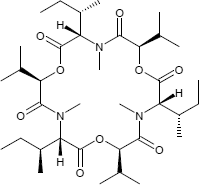 |
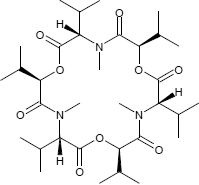 |
| Enniatin A | Enniatin B |
| C36H63N3O9 | C33H57N3O9 |
| CAS 2503-13-1 | CAS 917-13-5 |
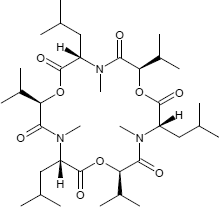 |
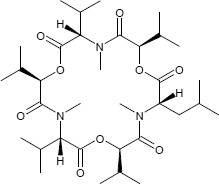 |
| Enniatin C | Ennniatin D (B4) |
| C36H63N3O9 | C34H59N3O9 |
| CAS 19893-23-3 | |
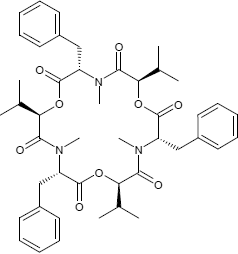 | |
| Beauvericin | |
| C45H57N3O9 | |
| CAS 26048-05-5 |
Systematische Namen
Enniatin A:
(3S,6R,9S,12R,15S,18R)-3,9,15-Tri[(2S)-2-butanyl]-6,12,18-triisopropyl-4,10,16-trimethyl-1,7,13-trioxa-4,10,16-triazacyclooctadecan-2,5,8,11,14,17-hexon.
Cyclo((2R)-2-hydroxy-3-methylbutanoyl-N-methyl-L-isoleucyl-(2R)-2-hydroxy-3-methylbutanoyl-N-methyl-L-isoleucyl-(2R)-2-hydroxy-3-methylbutanoyl-N-methyl-L-isoleucyl).
Enniatin B:
(3S,6R,9S,12R,15S,18R)-3,6,9,12,15,18-Hexaisopropyl-4,10,16-trimethyl-1,7,13-trioxa-4,10,16-triazacyclooctadecan-2,5,8,11,14,17-hexon.
Enniatin C:
3,9,15-Triisobutyl-6,12,18-triisopropyl-4,10,16-trimethyl-1,7,13-trioxa-4,10,16-triazacyclooctadecan-2,5,8,11,14,17-hexon.
Enniatin D = Enniatin B4:
(3S,6R,9S,12R,15S,18R)-3-isobutyl-6,9,12,15,18-pentaisopropyl-4,10,16-trimethyl-1,7,13-trioxa-4,10,16-triazacyclooctadecan-2,5,8,11,14,17-hexon.
Beauvericin:
(3S,6R,9S,12R,15S,18R)-3,9,15-Tribenzyl-6,12,18-triisopropyl-4,10,16-trimethyl-1,7,13-trioxa-4,10,16-triazacyclooctadecan-2,5,8,11,14,17-hexon.
Quellen und Literaturhinweise
[1] - E. Gäumann, Stephi Roth, L. Ettlinger, Pl. A. Plattner, U. Nager:
Enniatin, ein neues, gegen Mykobakterien wirksames Antibiotikum.
Experientia, (1947), DOI 10.1007/BF02163993.
[2] - Tapan K. Audhya, Douglas W. Russell:
Natural enniatin A, a mixture of optical isomers containing both erythro-and threo-N-methyl-L-isoleucine residues.
Journal of the Chemical Society, Perkin Transactions 1, (1974), DOI 10.1039/P19740000743.
[3] - Pornrapee Vongvilai et al.:
Isolation and Structure Elucidation of Enniatins L, M1, M2, and N: Novel Hydroxy Analogs.
Helvetica Chimica Acta, (2004), DOI 10.1002/hlca.200490185.
[4] - Arlene A. Sy-Cordero, Cedric J. Pearce, Nicholas H. Oberlies:
Revisiting the enniatins: a review of their isolation, biosynthesis, structure determination and biological activities.
The Journal of Antibiotics, (2012), DOI 10.1038/ja.2012.71.
[5] - CONTAM:
Scientific Opinion on the risks to human and animal health related to the presence of beauvericin and enniatins in food and feed.
In: EFSA Journal, (2014), DOI 10.2903/j.efsa.2014.3802, open access.
Kategorie: Stoffgruppen
Aktualisiert am 23. Juni 2023.
Permalink: https://www.internetchemie.info/chemie-lexikon/stoffgruppen/e/enniatine.php
© 1996 - 2024 Internetchemie ChemLin